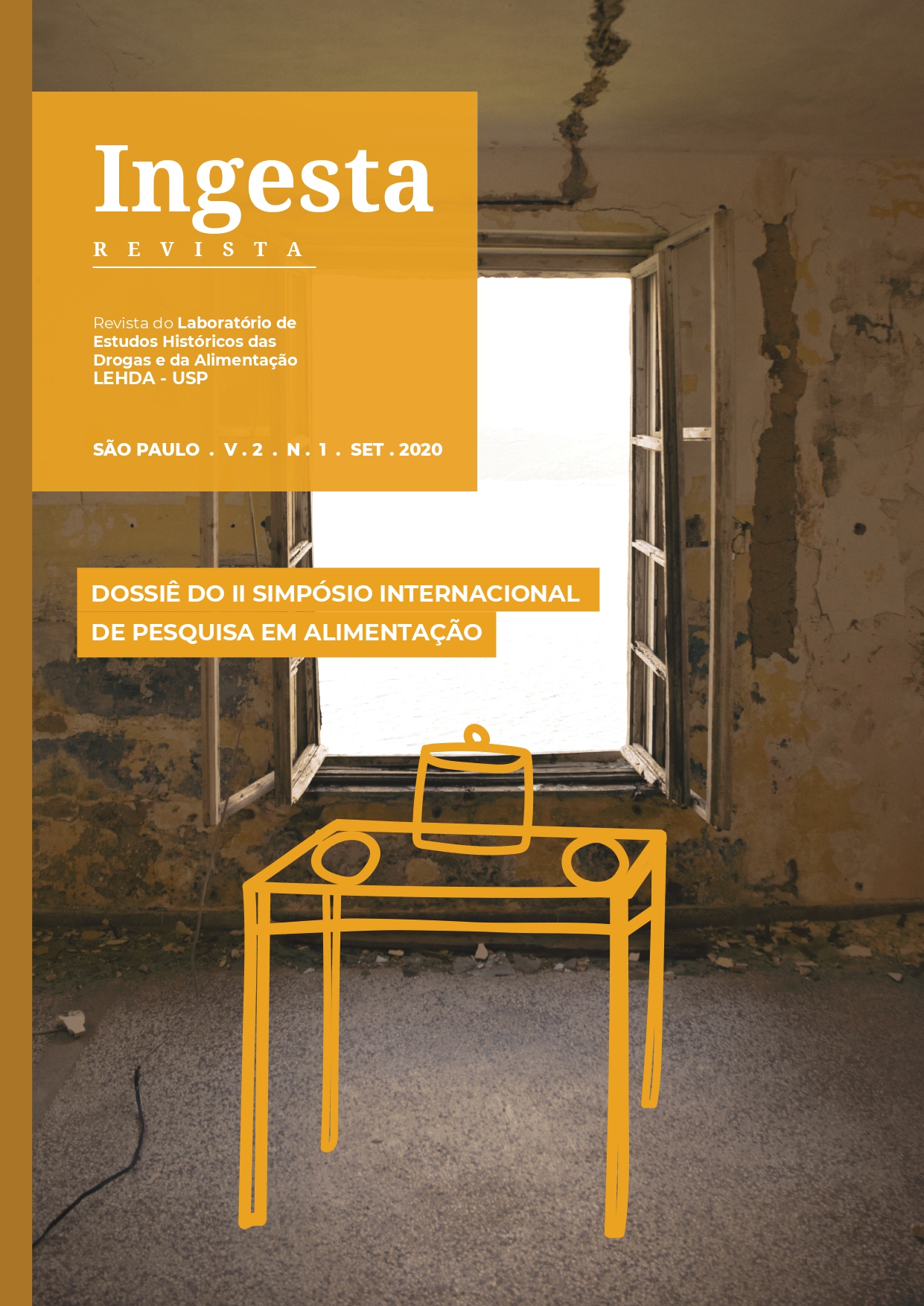Sacralized grains: notes on the popular diffusion of maize from their symbolic use in religious rituals
DOI:
https://doi.org/10.11606/issn.2596-3147.v2i1p118-136Keywords:
maize, Food History, afro-indigenous, sacredness, poeticsAbstract
Observing the symbolic meanings of the Brazilian maize culture unveils its importance as a food of resistance associated with a sacredness hardly visible to official historiography. From the colonizer’s perspective, maize was of little relevance other than the economic and did not rival wheat, whose symbolic value was associated with Christianity. Investigating the mentions made about maize in the book A Culinary History, organized by Flandrin and Montanari, we found the idea that in Europe maize was recommended only during periods of supply crisis. Differently, in Brazil, we note that the diffusion of maize in popular alimentation was mainly due to Afro-descendant peoples who adapted their domestic and ritualistic use. Although information on the use of food in the original religions of the native and captive peoples is rare, it was possible, through anthropological and artistic studies, to compare some current ritualistic practices inherited from the indigenous and Afro-descendant ethnic groups of the Brazilian colonial period. The comparison shows similarities between the Afro-indigenous religious rituals that point to their unity, which proved to be valuable for the survival of maize in the Brazilian diet. The study on the sacredness of maize points to ways of transmitting a food culture surrounded by clashes between its socioeconomic representations and its symbolic potentialities, both magical and poetical.
Downloads
References
ALVES, Julyane Paz Dominguez dos Santos; MESSIAS, Luana Costa Pierre de. Pipocando: a pipoca nos rituais religiosos afro-indígenas. In: ALBUQUERQUE, Gerson Rodrigues de; ISHII, Raquel Alves; NASCIMENTO, Francemilda Lopes do (ed.). Anais do IX Simpósio Linguagens e Identidades da/na Amazônia Sul-Ocidental: línguas e literaturas indígenas, Universidade Federal de Rio Branco, nov. 2015. Rio Branco: Nepan Editora, 2015, p. 350-365.
BASSO, Rafaela. A cultura alimentar paulista: uma civilização do milho? (1650-1750). São Paulo: Alameda, 2014.
BASSO, Rafaela. O lugar da alimentação nos estudos históricos da Escola dos Annales. Revista Helikon, Curitiba, v. 2, n. 3, p. 50-63, 2015.
BASSO, Rafaela. Avati na mesa e no sertão: um pouco da história do milho na colonização da América Portuguesa. In: MELCHIOR, Myriam (org.). Gastronomia, cultura e memória: por uma cultura brasileira do milho. Rio de Janeiro: Fólio Digital, 2017, p. 57-70.
BIRLOUEZ, Éric. Festins princiers et repas paysans à la renaissance. Rennes: Editions Ouest-France, 2014.
CAMARGO, Maria Thereza Lemos de Arruda. O milho e a mandioca: nas cozinhas brasileiras, segundo contam suas histórias (Série Cadernos de Folclore, v. 18). São José dos Campos: Centro de Estudos da Cultura Popular/Fundação Cultural Cassiano Ricardo, 2008.
CASTRO, Eduardo Viveiros de. A inconstância da alma selvagem. São Paulo: Cosac & Naify, 2002.
COE, Sophie. America’s first cuisines. Austin: University of Texas Press, 1984.
FLANDRIN, Jean-Louis. Os tempos modernos. In: FLANDRIN, Jean-Louis; MONTANARI, Massimo. História da alimentação. 8 ed. São Paulo: Estação Liberdade, 2015.
FLECK, Eliane Cristina Deckmann. Apresentação. In: FLECK, Eliane Cristina Deckmann (org.). Religiões e religiosidades no Rio Grande do Sul: manifestações da religiosidade Indígena. v 3. São Paulo: ANPUH, 2014, p. 11-24.
FREIXA, Dolores; CHAVES, Guta. Gastronomia no Brasil e no Mundo. 2 ed. Rio de Janeiro: Editora Senac, 2012.
LIMA, Cláudia. Tachos e panelas: historiografia da alimentação brasileira. Recife: Raízes Brasileiras, 2009.
MELCHIOR, Myriam. Memória e resistência: argumentos para a valorização de uma cultura do milho particularmente brasileira. In: MELCHIOR, Myriam (org.). Gastronomia, cultura e memória: por uma cultura brasileira do milho. Rio de Janeiro: Fólio Digital, 2017, p. 64-79.
MENEZES NETO, Hugo. Que cheirinho bom! O milho para além do comer. In: MENASCHE, Renata; ALVAREZ, Marcelo; COLAÇO, Janine (orgs.). Dimensões socioculturais da alimentação: diálogos latino-americanos. Porto Alegre: Editora da UFRGS, 2012, p. 119-134.
MORS, Luiz. O milho e suas polêmicas envolvendo os aminoácidos. In: MORS, Luiz. O Etnobotânico.
Rio de Janeiro, 31 jul. 2014. Disponível em: https://oetnobotanico.wordpress.com/2014/07/31/o-milho-e-suas-polemicas-envolvendo-aminoacidos. Acesso em: 28 jul. 2020.
SILVA, Vagner Gonçalves da. Formação e dinâmica das religiões afro-brasileiras. In: SILVA, Eliane Moura da; BELLOTTI, Karina Kosicki; CAMPOS, Leonildo Silveira (orgs.). Religião e sociedade na América Latina. São Bernardo do Campo: Universidade Metodista de São Paulo, 2010, p. 93-100.
PIMENTEL, Myriam Melchior; MELCHIOR, Laila. Reencantamentos e novas apropriações: alimento como vivência e memória na arte brasileira. Esferas, Brasília, ano 4, n. 6, p.143-154, jan./jun. 2015.
POULAIN, Jean-Pierre. Sociologias da alimentação: os comedores e o espaço social alimentar. Florianópolis: Editora UFSC, 2013.
Downloads
Published
Issue
Section
License
1. Authors retain the copyright and grant the journal the right of first publication, with the work simultaneously licensed under the Creative Commons Attribution License which allows the sharing of work with acknowledgment of authorship and initial publication in this journal.
2. Authors are authorized to take additional contracts separately, for non-exclusive distribution of the version of the work published in this journal (eg. publish in institutional repository or as a book chapter), with acknowledgment of authorship and initial publication in this journal.
3. Authors are allowed and encouraged to publish and distribute their work online (eg. in institutional repositories or on their personal page) at any point before or during the editorial process, as this can generate productive changes as well as increase the impact and the citation of the published work (See The Effect of Free Access).


